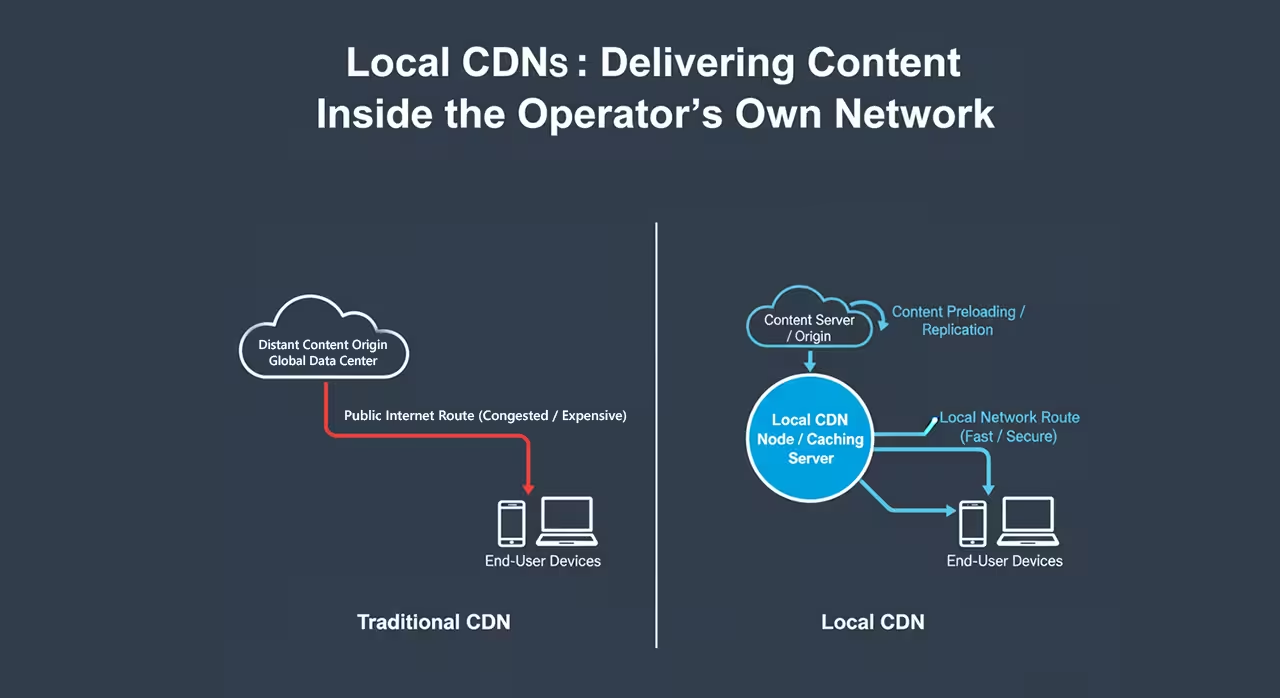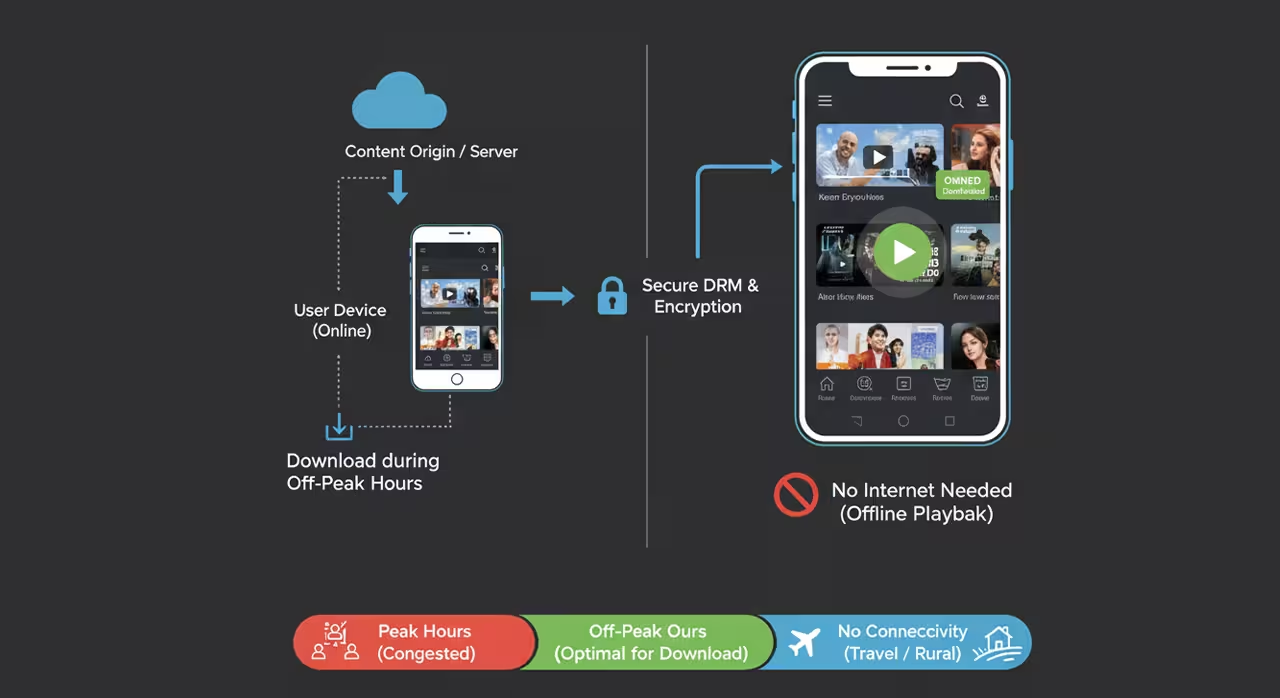
How Local CDNs Empower OTT Growth in Low-Bandwidth Regions
Emerging markets are becoming the next major growth engines for OTT services. Across Africa, LATAM, and South Asia, millions of viewers are discovering digital entertainment for the first time. Yet despite this surge in demand, many operators face the same persistent challenge t.i. unstable, low-bandwidth internet connections that make consistent streaming difficult.
Long buffering times, playback interruptions, and inconsistent quality can quickly drive users away. In markets where mobile data is expensive and connectivity is unreliable, delivering a great viewing experience requires more than just a strong content library. It requires a smarter delivery infrastructure.
To overcome these hurdles, operators are turning to local CDNs with adaptive streaming, edge caching, and Download-to-Own (DTO) capabilities. These technologies allow OTT operators to maintain superior quality, minimize bandwidth costs, and expand into regions that were previously underserved by global networks.
Local CDNs: Delivering Content Inside the Operator’s Own Network

In low-bandwidth regions, the biggest bottleneck often lies not in content creation or encoding, but in content delivery. Traditional CDN models depend on global infrastructure. These are large-scale networks of distributed servers often owned by third-party providers. While effective for global reach, they can introduce inefficiencies for operators serving users within specific, localized regions.
A local CDN, by contrast, operates entirely within the operator’s own managed and closed network. This means that all streaming requests are handled locally, without passing through congested public internet routes or third-party data centers.
This approach offers multiple advantages:
- Elimination of external transit costs: Since content stays within the operator’s network, there’s no need to pay for international bandwidth or transit fees.
- Significantly reduced latency: The content is delivered from servers located physically closer to end-users often inside the same ISP or telco infrastructure.
- Predictable quality and reliability: Because delivery happens within a controlled environment, operators can guarantee a higher and more stable QoE (Quality of Experience).
- Improved data security and privacy: Sensitive data and user activity remain within the operator’s trusted network perimeter.
For instance, an ISP or mobile operator in Sub-Saharan Africa using UniqCast’s integrated CDN can deploy caching nodes directly within their local network. When users stream live or on-demand content, it is served instantly from the operator’s own infrastructure ensuring minimal buffering even when external connectivity is limited.
UniqCast’s CDN module is designed for exactly this scenario. It enables flexible deployment of on-premise or hybrid (global-local) CDN topologies, complete with smart caching, content replication, and performance analytics. Operators gain full control over their content flow and can scale effortlessly as demand grows without relying on global third-party CDNs.
Adaptive Streaming: Smart Quality for Every Connection

Even with optimized delivery, network conditions in emerging markets can fluctuate dramatically. Adaptive Bitrate Streaming (ABR) ensures that users always get the best possible experience for their current bandwidth. This means automatically adjusting video quality in real-time without interruptions.
If bandwidth drops, the stream smoothly shifts to a lower resolution; when connectivity improves, it upgrades again. This all happens without user input or rebuffering.
For operators, this flexibility is essential to keeping users engaged and satisfied across a wide range of devices and network types from urban fiber connections to rural 3G/4G networks.
The UniqCast Platform incorporates a highly optimized ABR engine that dynamically balances quality, performance, and bandwidth efficiency. This helps operators serve high-quality content even to users on mobile data or fluctuating network conditions, ensuring broad accessibility and customer satisfaction.
Edge Caching and Preloading: Efficiency Meets Speed

Complementing local CDNs, edge caching further enhances delivery efficiency by storing the most popular or frequently accessed content directly at the edge of the operator’s network as close to the end-user as possible.
This means that when viewers request popular titles such like local dramas, sports highlights, or trending VOD assets the content is retrieved from a nearby cache node rather than from a distant central server.
The benefits are substantial:
- Instant access and reduced buffering for end-users.
- Lower backbone traffic, reducing network strain and operational costs.
- Predictable performance, especially during peak viewing hours.
Content preloading takes this concept one step further. Operators can proactively push upcoming or high-demand titles to local nodes before they are released ensuring instant availability at launch. For example, a regional operator might preload the next episode of a hit series across its edge servers overnight, so users can start streaming immediately the next day.
The UniqCast platform automates this workflow, combining caching intelligence with analytics-driven prediction of user behavior and content popularity.
Download-to-Own (DTO): Offline Access Beyond Streaming

Streaming may be the default mode of consumption, but in low-bandwidth regions, offline accessibility can make or break the user experience. Download-to-Own (DTO) is a powerful feature that enables users to download VOD titles directly to their devices and keep them permanently.
Unlike temporary offline downloads, DTO offers permanent ownership, allowing users to access their purchased content anytime, anywhere, without needing an active connection.
Key Use Cases:
- Travel and commuting: Viewers can enjoy their favorite shows during flights, road trips, or train journeys without relying on mobile data.
- Low-connectivity areas: Families and students in rural areas can download content once and watch it repeatedly offline.
- Monetization potential: Operators can sell DTO titles as premium content, adding a new revenue stream beyond subscriptions or advertising.
DTO also has network efficiency advantages. By encouraging users to download during off-peak hours, operators can balance bandwidth demand and minimize peak-hour strain.
Through UniqCast’s built-in DTO module, operators can securely manage offline content with advanced encryption, DRM support, and usage rights enforcement ensuring both user convenience and content provider protection.
Business Opportunities for OTT Operators

Adopting these technologies opens new pathways for operators in emerging markets to grow sustainably and profitably:
- Expand coverage into previously unreachable regions by ensuring consistent performance even on weak networks.
- Improve customer satisfaction with smoother streaming and offline access options.
- Monetize premium content through DTO or hybrid subscription models.
- Reduce OPEX by hosting a local CDN within their own network, avoiding costly external bandwidth.
- Enhance security and control, maintaining all delivery operations inside the operator’s trusted environment.
For many operators, this shift from dependence on global CDNs to localized delivery ecosystems is a strategic evolution that ensures future competitiveness and user trust.
Local Control, Global Experience

The next phase of OTT growth will come from regions where connectivity remains a challenge and where innovation defines success.
By building local CDNs inside their own managed networks, operators gain full control over performance, quality, and cost. When combined with adaptive streaming, edge caching, and Download-to-Own, this approach enables them to deliver a world-class viewing experience to every user, regardless of internet stability or location.
Through its unified platform, UniqCast empowers operators to make this vision a reality offering a complete, secure, and scalable OTT ecosystem built for low-bandwidth regions and high user expectations alike.
In the future of streaming, connectivity may differ but experience shouldn’t. With UniqCast, every operator can deliver premium-quality content on any network, anywhere.




